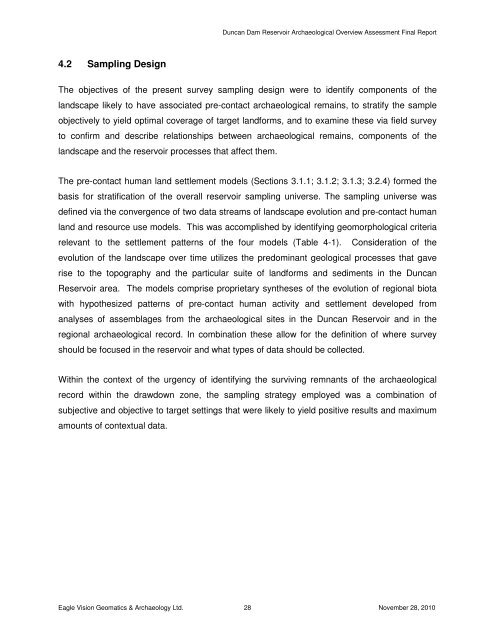November 2010 - BC Hydro
November 2010 - BC Hydro
November 2010 - BC Hydro
Create successful ePaper yourself
Turn your PDF publications into a flip-book with our unique Google optimized e-Paper software.
4.2 Sampling Design<br />
Duncan Dam Reservoir Archaeological Overview Assessment Final Report<br />
The objectives of the present survey sampling design were to identify components of the<br />
landscape likely to have associated pre-contact archaeological remains, to stratify the sample<br />
objectively to yield optimal coverage of target landforms, and to examine these via field survey<br />
to confirm and describe relationships between archaeological remains, components of the<br />
landscape and the reservoir processes that affect them.<br />
The pre-contact human land settlement models (Sections 3.1.1; 3.1.2; 3.1.3; 3.2.4) formed the<br />
basis for stratification of the overall reservoir sampling universe. The sampling universe was<br />
defined via the convergence of two data streams of landscape evolution and pre-contact human<br />
land and resource use models. This was accomplished by identifying geomorphological criteria<br />
relevant to the settlement patterns of the four models (Table 4-1). Consideration of the<br />
evolution of the landscape over time utilizes the predominant geological processes that gave<br />
rise to the topography and the particular suite of landforms and sediments in the Duncan<br />
Reservoir area. The models comprise proprietary syntheses of the evolution of regional biota<br />
with hypothesized patterns of pre-contact human activity and settlement developed from<br />
analyses of assemblages from the archaeological sites in the Duncan Reservoir and in the<br />
regional archaeological record. In combination these allow for the definition of where survey<br />
should be focused in the reservoir and what types of data should be collected.<br />
Within the context of the urgency of identifying the surviving remnants of the archaeological<br />
record within the drawdown zone, the sampling strategy employed was a combination of<br />
subjective and objective to target settings that were likely to yield positive results and maximum<br />
amounts of contextual data.<br />
Eagle Vision Geomatics & Archaeology Ltd. 28 <strong>November</strong> 28, <strong>2010</strong>

















